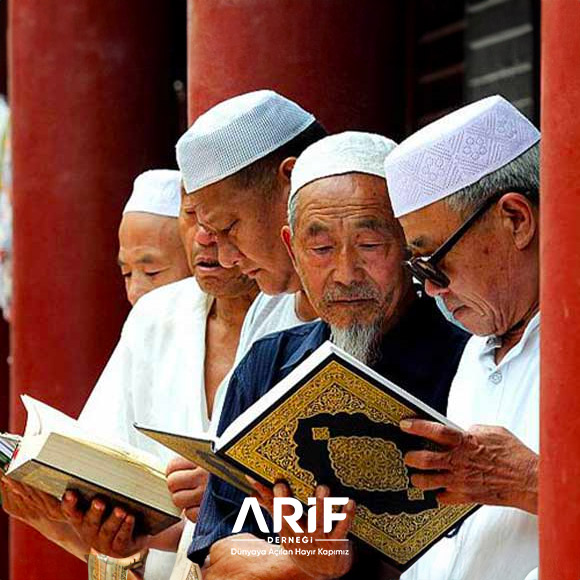Blog
The Dungan Muslims In China

Who are the Dungans?” is a question that many of us might not have an immediate answer to…
Yet, the Dungans are one of the most fascinating communities in Eurasia. With fathers of Arab descent and mothers from China, the Dungans are a people who, though little known today, were able to live according to their beliefs without compromise during the Soviet era.
Muhammad, Rahime, Ferit, Nesibe, Zeynep, Hüseyin, Amina, Fatima… These names sound so familiar, don’t they? When you encounter these names in villages and towns along the historic Silk Road in the heart of Central Asia, you’re even more amazed.
Some say there are 7 million Dungans in China, while others claim the number is 100 million…
With their almond-shaped eyes and serene smiles, these people greet us as Chinese Muslims. They are known as “Dungans” and live near the Chinese border in Kyrgyzstan. According to official statistics, their numbers in Kyrgyzstan are around 60,000. The majority, however, live in China, and estimates of their population vary. Some sources mention the Dungan population in China could be as high as 7 million, while others claim it reaches 100 million.
Referred to as “Döngen” or “Tungan” in various sources, the Dungans are a society that emerged as a result of Arab-Chinese marriages. Their most distinguishing feature is their strong attachment to their faith. Even during the Soviet era, when communism was at its harshest and there was immense pressure on religion, they did not compromise on their beliefs, prayers, or way of life. Today, approximately 30% of the Dungans living in Kyrgyzstan reside in Tokmok, northeast of the capital.
Tokmok is a historic city in the region where the famous Turkish scholar Yusuf Has Hacip, author of Kutadgu Bilig, lived. According to a local legend, his grave is also here. Tokmok, nestled at the foot of the spiritually significant Tian Shan Mountains, is home to a museum dedicated to Yusuf Has Hacip.
The Beginning of China’s Contact with the Islamic World
China’s contact with the Islamic world began in the 7th century. Sources vary on when Islam first entered China, but the most widely accepted view is that it started in 651. According to Islamic texts, an envoy sent by the third Caliph, Uthman, arrived in the capital of the Tang Dynasty, Chang’an, on August 25, 651. A popular legend among Chinese Muslims holds that Islam was first introduced to China by Sa’d ibn Abi Waqqas, one of the Ten Companions promised paradise, and that his grave is located in the city of Canton.
The Dungans: One of the Largest Muslim Communities
Some Muslim authors suggest that considering the high birth rates among Muslims, the Dungan population in China may range from 70 to 100 million. If this is the case, the Dungans could be one of the largest Muslim communities in the world. The vast majority of Dungans follow the Hanafi school of thought and adhere to Sunni Islam.
The arrival of the Dungans in Kyrgyzstan dates back to the 1960s. During this time, Soviet Kyrgyzstan received Chinese families, and there are varying accounts of why they came. The most common explanation is that the Soviet government brought them to teach agriculture to the Kyrgyz people. Today, the Dungans are known as the community that taught agriculture to the Kyrgyz. The majority still make their living through agricultural production.
Life in Tokmok
During our visit to the home of the Chinshailo family in Bishkek, we saw that their home resembled those of many villages in Anatolia. A large garden, an open area referred to as the “hayat” in Anatolia, rooms furnished with sofas and floor cushions. Zeynep Nine, the matriarch of the family, is 68 years old and was born in Tokmok. Her father participated in World War II on the Soviet Union’s side and never returned. The family’s uncle, Sherba Chinshailo, is deeply interested in Dungan history. He explains that the Arab-Chinese unions trace back to the 600s and 700s, and the Dungans, as a distinct group, began to emerge around the 11th century.
The Dungans’ Development
The Dungans have their own language, called ‘Dunganca,’ which resembles Chinese in many ways. Sherba Chinshailo notes, “If the Chinese speak slowly, we can understand them; but if they speak quickly, we cannot.” He also laments that despite their Arab ancestry, their language bears no trace of Arabic.
Dungans prefer to live in communities, and there are many Dungan villages across Kyrgyzstan. According to Sherba Chinshailo, their ancestors migrated from China in family units, and this tradition continues today. The Dungans’ skills in agriculture are undeniable, and Sherba Chinshailo jokes, “The Kyrgyz only know how to eat. If it weren’t for us, they would go hungry.”
During the Soviet era, the Dungans faced many hardships, but they never abandoned their faith. Sherba Chinshailo recalls how they secretly practiced their religion, despite the government’s restrictions. “Our elders used to rent houses for the poor in the city. But those houses were actually used as places of worship. We would gather there for prayers, and it was a way to outsmart the authorities. Even during that time, we found ways to pray together.”
Islam’s Spread in China
The first mosque in China was built in the 60th year after the Hijra. Xi’an, the imperial capital of China, was also one of the first places where Islam spread and took root. Chinese Muslims claim that there are graves of Companions and Tabi’un in China, including the tomb of Sa’d ibn Abi Waqqas in Canton.
In China, Muslims belong to ten different ethnic groups, including Tatars, Uighurs, Mongols, Hans, Kazakhs, Tajiks, and Uzbeks. Due to this diversity, Muslim communities in China often participate in “brotherhood tours,” where Muslims from around the world visit their Chinese Muslim counterparts in places like Beijing and Xi’an. This practice has garnered significant interest from Muslim communities in the UK, Singapore, Malaysia, and Central Asia
